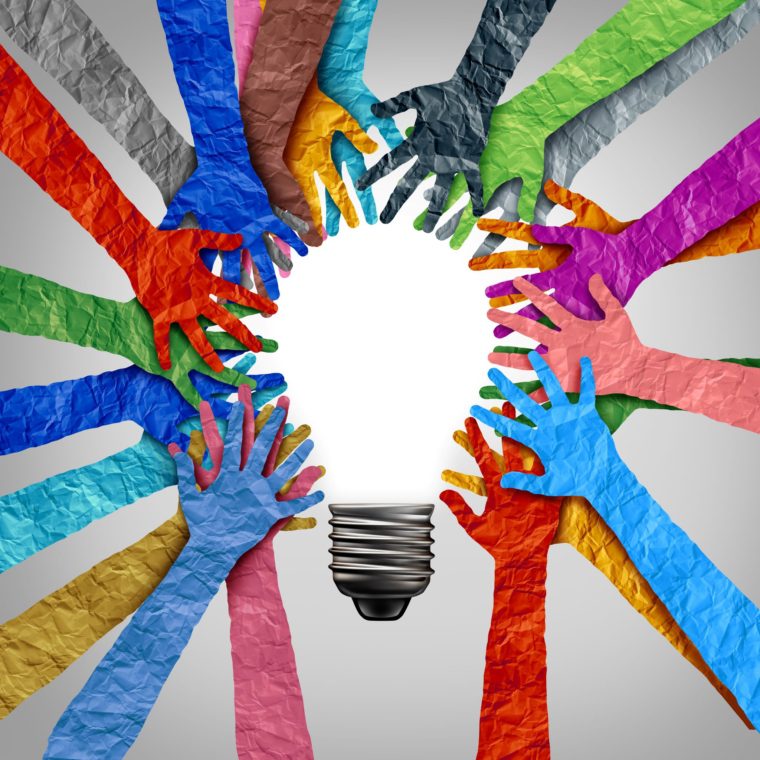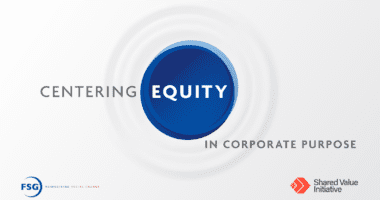This is the second in a series of articles based on the guide to Centering Equity in Corporate Purpose published by FSG and the Shared Value Initiative in May 2022.
Society is asking the private sector to play a larger role in advancing equity. For the second year in a row, respondents to the 2022 Edelman Trust Barometer ranked business as the most trusted institution over government, NGOs, and media. Leadership in addressing societal issues and reducing inequities is now seen as a core function of business.
But companies cannot address issues of equity through “business as usual.” Companies must be in relationship with the problem. They need to foster trust and nurture authentic relationships with the communities experiencing the inequities. They need to leverage their engines of innovation. Most of all, they need to push beyond the obvious as they identify specific domains where they can have the most impact.
In our recently released guide, Centering Equity in Corporate Purpose, we put forward five practices for placing equity at the center of corporate purpose. The first practice—new materiality—helps companies identify the equity issues that matter to their business. The second practice identifies and prioritizes “equity domains”—the specific dimensions of equity where a company can create the most change, on its own and through industry and cross-sector collaboration. Selecting equity domains requires that companies think holistically and challenge themselves to avoid cherry-picking domains that are simpler and require less change from current modes of operating. Pushing beyond the easy and obvious answers will surface opportunities to create new value in areas that are core to the company’s current business and in new areas of operation and sources of value for the company.
Choosing your equity domains can be hard, as it means making decisions about which societal problems you will and will not focus on. It requires a deep understanding of the impact your business has on society and society on your business, and to be authentic and effective it must be done in collaboration with partners and communities who are experiencing inequities.
I’m lucky to be joined by Patricia Mae (Patti) Doykos, Ph.D., who is the Executive Director of Health Equity at Bristol Myers Squibb, an innovative biopharma company, to share her experience of leading this process of identifying and selecting equity domains at Bristol Myers Squibb under the broader equity issue area of health equity. In 2021, Patti became BMS’s first Executive Director of Health Equity, where she leads internal and external health equity efforts across the organization. She started her career at Bristol Myers Squibb by spending five years in HIV/AIDS commercial business and oncology R&D communications and serving as a Senior Director in the Bristol Myers Squibb Foundation for nearly two decades.
Patti, can you start by telling us how you define “health equity”? Why is health equity important for Bristol Myers Squibb and central to the organization’s purpose?
Health equity is the just and fair opportunity for all people to achieve their optimal health outcomes. As a specialty care biopharmaceutical company, innovation to help patients prevail over serious diseases is at the core of what Bristol Myers Squibb does and Inclusion is a company value. Inclusion breeds innovation. We aim to leave no patient behind, and currently we are not reaching every patient that needs our life-saving therapeutics. As a patient-centered company, we ask ourselves every day, “Who are you working for?” With our commitment to health equity, we also ask ourselves, “Who aren’t we working for yet, and how we will bring these patients into view and evolve our research and business to engage and reach them?”
Bringing a health equity lens to everything we do is an opportunity to modernize and deepen our patient centered purpose, expand our science and the reach and impact of our medicines, particularly for medically underserved and increasingly diverse patient populations around the world. It is a core priority for Bristol Myers Squibb. We are evolving our business model and building new capabilities to live into our commitment to health equity. We’ve made commitments to help address disparities in health care, increase diversity in clinical trials, expand the supply chain to include more diverse suppliers, enhance our employees’ ability to give back to the community and increase the diversity of our own workforce. We work cross-functionally across the organization to achieve these health equity commitments.
Health equity is a very broad issue area and an extremely ambitious goal. What has Bristol Myers Squibb identified as the specific domains of health equity where you will focus on creating change as a company?
We identified two domains under the broader area of health equity where we will focus. The first is to bring inclusion intentionally to our mission to discover, develop, and deliver innovative therapies; the second is to advance healthcare solutions beyond therapies.
Each of these domains is still quite broad, so we went one level deeper and identified specific opportunities within each domain. The first domain – inclusively discover, develop, and deliver innovative therapies – comprises opportunities to better account for diverse patient populations and socioeconomic contexts in our innovation processes, advancing inclusive R&D including and beyond diversity in clinical trials, bolstering clinical trial infrastructure, and rethinking commercialization of our medicines to maximize reach particularly for medically underserved populations. The second domain – advancing healthcare solutions beyond therapies – includes opportunities to improve clinical quality — particularly in specialty care — with a focus on those populations experiencing the greatest healthcare inequities, and to account for and address social and structural determinants of health with the goal to support the patient journey more fully and to transform even more lives.
The first domain makes a lot of sense. It flows from what most people see as the mandate of most innovator biopharma companies to create and deliver critical therapeutics and medicines that address unmet medical need. Tell us more about the second domain – advancing solutions beyond therapies. It sounds out of the norm for where many people may typically see a biopharma company operate. Why is it important for BMS to address it? Why did you include it as one of your health equity domains? Why is BMS best positioned to address it and how does it create value for your company?
As one of the leading biopharma companies in the world, Bristol Myers Squibb has an opportunity to influence within the industry, with our partners, and other sectors. Counteracting the prevailing mindset that biopharma companies are limited to addressing health equity through therapies is part of our role as an industry leader. We also have a strong history of thinking beyond our medicines to advance health equity both in the commercial business and through the work of the Bristol Myers Squibb Foundation.
In 1997, when I joined Bristol Myers Squibb, the company was on the scientific front lines of the HIV/AIDS response. The introduction of highly active antiretroviral therapy (HAART) therapy gave people living with HIV a chance to effectively fight the virus and reclaim their health and lives. Still, more had to be done to ensure there was a fair and just opportunity for those in the hardest-hit regions to benefit from this medical innovation. That required thinking beyond the therapy to address the other barriers making it difficult for people living with HIV to access treatment. Through multisector public-private partnerships and novel company business actions Bristol Myers Squibb made important health equity contributions to the global response that increased research, access to treatment, care and support, and advanced sustaining policies.
It won’t be easy – and the solutions are most certainly not immediately obvious – but the second domain builds on Bristol Myers Squibb’s legacy of approaching enormous challenges and rolling up our sleeves to innovate, collaborate, and get life-saving treatment to patients and communities that need them.
As mentioned earlier, selecting equity domains is hard. Can you tell us about Bristol Myers Squibb’s process for choosing these equity domains? Who was involved in the process?
The challenge of health equity can seem intractable at times, and we can’t achieve health equity by ourselves. No one company, industry, or sector can. The path to advance health equity requires close collaboration, partnership, and listening, and we took a similar approach to identifying and choosing our health equity domains. We brought together a cross-functional working group of leaders across Bristol Myers Squibb and the Bristol Myers Squibb Foundation to inform the selection of these domains. Outside of BMS, we conducted extensive secondary research to understand the depth of health inequities and how these varied by context (e.g., taking a targeted focus on racial equity in the U.S. and on socioeconomic equity in other contexts). We engaged patients and community organizations in the process, as well as seeking the input of several experts within the industry and the broader health and healthcare sectors with significant experience and expertise in advancing approaches to health equity.
Now that you’ve identified Bristol Myers Squibb’s equity domains, what’s next in Bristol Myers Squibb’s health equity journey?
Our goal is to continue executing against our inclusion and diversity health equity commitments to address disparities in healthcare. We will capture impact and report on our progress annually through our Global Inclusion and Diversity report. We will continue to work cross-collaboratively to educate and engage our teams across functions, leverage a global approach to health equity and align our efforts around the world.
Thank you, Patti, for your generosity and vulnerability in sharing about Bristol Myers Squibb’s health equity journey and the process to identifying and selecting specific health equity domains where, as a company, you are best positioned to and are most important for you to address. As you said, the journey ahead is hard – to say the least – but it is a critical one and will require more companies like BMS working in collaboration with each other, government, NGOs, communities, and other industries to overcome these barriers so that all people have a just and fair opportunity to achieve optimal health outcomes. We look forward to continued learnings and insights as Bristol Myers Squibb advances on its journey to achieve that vision.
Nikhil Bumb (he/him) is a Managing Director at FSG, a mission-driven social impact advisory organization seeking to create equitable systems change.
Patricia Mae Doykos, Ph.D., (she/her) is the Executive Director for Health Equity at Bristol Myers Squibb.





